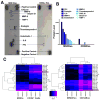Angiogenic Mechanisms of Human CD34+ Stem Cell Exosomes in the Repair of Ischemic Hindlimb
- PMID: 28298297
- PMCID: PMC5420547
- DOI: 10.1161/CIRCRESAHA.116.310557
Angiogenic Mechanisms of Human CD34+ Stem Cell Exosomes in the Repair of Ischemic Hindlimb
Abstract
Rationale: Paracrine secretions seem to mediate therapeutic effects of human CD34+ stem cells locally transplanted in patients with myocardial and critical limb ischemia and in animal models. Earlier, we had discovered that paracrine secretion from human CD34+ cells contains proangiogenic, membrane-bound nanovesicles called exosomes (CD34Exo).
Objective: Here, we investigated the mechanisms of CD34Exo-mediated ischemic tissue repair and therapeutic angiogenesis by studying their miRNA content and uptake.
Methods and results: When injected into mouse ischemic hindlimb tissue, CD34Exo, but not the CD34Exo-depleted conditioned media, mimicked the beneficial activity of their parent cells by improving ischemic limb perfusion, capillary density, motor function, and their amputation. CD34Exo were found to be enriched with proangiogenic miRNAs such as miR-126-3p. Knocking down miR-126-3p from CD34Exo abolished their angiogenic activity and beneficial function both in vitro and in vivo. Interestingly, injection of CD34Exo increased miR-126-3p levels in mouse ischemic limb but did not affect the endogenous synthesis of miR-126-3p, suggesting a direct transfer of stable and functional exosomal miR-126-3p. miR-126-3p enhanced angiogenesis by suppressing the expression of its known target, SPRED1, simultaneously modulating the expression of genes involved in angiogenic pathways such as VEGF (vascular endothelial growth factor), ANG1 (angiopoietin 1), ANG2 (angiopoietin 2), MMP9 (matrix metallopeptidase 9), TSP1 (thrombospondin 1), etc. Interestingly, CD34Exo, when treated to ischemic hindlimbs, were most efficiently internalized by endothelial cells relative to smooth muscle cells and fibroblasts, demonstrating a direct role of stem cell-derived exosomes on mouse endothelium at the cellular level.
Conclusions: Collectively, our results have demonstrated a novel mechanism by which cell-free CD34Exo mediates ischemic tissue repair via beneficial angiogenesis. Exosome-shuttled proangiogenic miRNAs may signify amplification of stem cell function and may explain the angiogenic and therapeutic benefits associated with CD34+ stem cell therapy.
Keywords: cardiovascular disease; cell transplantation; exosomes; hindlimb; ischemia; microRNA; stem cells.
© 2017 American Heart Association, Inc.
Figures








References
-
- Losordo DW, Kibbe MR, Mendelsohn F, Marston W, Driver VR, Sharafuddin M, Teodorescu V, Wiechmann BN, Thompson C, Kraiss L, Carman T, Dohad S, Huang P, Junge CE, Story K, Weistroffer T, Thorne TM, Millay M, Runyon JP, Schainfeld R. A randomized, controlled pilot study of autologous CD34+ cell therapy for critical limb ischemia. Circ Cardiovasc Interv. 2012;5:821–30. - PMC - PubMed
-
- Kawamoto A, Iwasaki H, Kusano K, Murayama T, Oyamada A, Silver M, Hulbert C, Gavin M, Hanley A, Ma H, Kearney M, Zak V, Asahara T, Losordo DW. CD34-positive cells exhibit increased potency and safety for therapeutic neovascularization after myocardial infarction compared with total mononuclear cells. Circulation. 2006;114:2163–9. - PubMed
-
- Kumar AH, Caplice NM. Clinical potential of adult vascular progenitor cells. Arteriosclerosis, thrombosis, and vascular biology. 2010;30:1080–7. - PubMed
MeSH terms
Substances
Grants and funding
LinkOut - more resources
Full Text Sources
Other Literature Sources
Molecular Biology Databases
Miscellaneous

